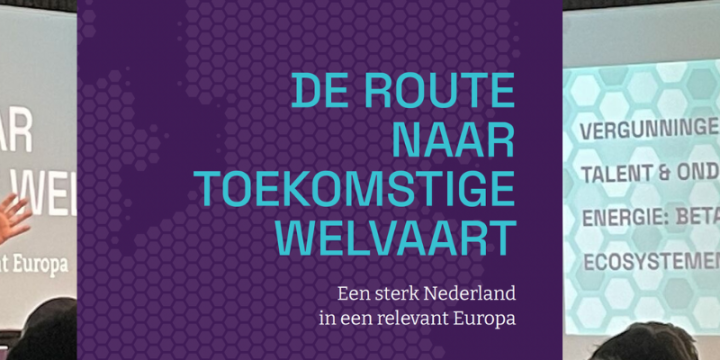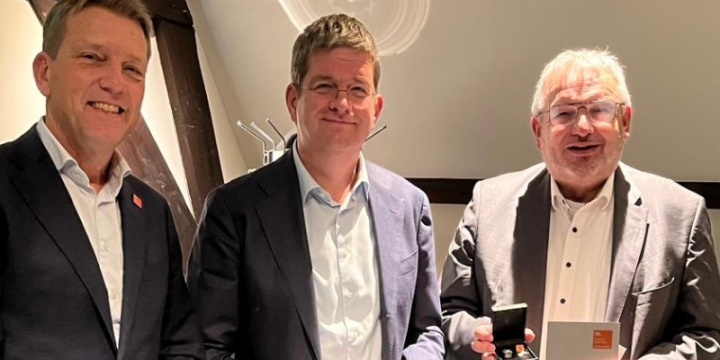When you think of the energy transition, wind turbines and solar panels immediately spring to mind. But being able to store sustainable energy effectively is just as important: in batteries, heat buffers, and by using hydrogen technology. The Netherlands can be a leader in energy storage—but only if we accelerate our efforts now. Recent research confirms this. Michiel Dorrepaal, program council member for the innovation domain Energy Materials at Holland High Tech, explains the challenges, opportunities, and the route to leadership.
This article is part of a series we're producing in collaboration with IO+. It introduces you to all the innovation domains of Holland High Tech. In this installment: the Energy Materials innovation domain.
Last year, for the first time, more than half of the Netherlands' electricity came from renewable sources. This is an important milestone, but at the same time, we face major challenges. Our power grid is under pressure. Wind and solar parks have to be shut down regularly. We need to significantly accelerate energy storage, as storage systems can be seen as a ‘parking lot’ for sustainable electricity.
European flexibility demand will increase fivefold over the next ten years to 1,608 TWh – a market worth hundreds of billions of euros. Dorrepaal expects Europe to want to become self-sufficient in energy storage quickly. “Dependence on foreign suppliers of critical technologies, such as electrolyzers, for example, from China, is too risky. With knowledge and innovative power, the Netherlands can play a key role in Europe's independent energy market.” Energy Materials has been named one of the ten priority key technologies in the National Technology Strategy, in which the government, businesses, and knowledge institutions are joining forces.
The Dutch battery market
First of all: batteries. Much is going well in the Dutch battery market. In 2024, the market reached 1 GWh of storage capacity. By 2025, 2.1 GWh is expected, while projects of more than 15 GWh are in the pipeline. A much-needed development, according to Dorrepaal. “During the day, more energy is often generated than is needed; in the evening and at night, you need extra power. Batteries make it possible to balance those peaks and troughs.”
In the Netherlands, not only is a lot of work being done to increase capacity, but a lot of effort is also being put into sustainability. Many batteries today still rely on scarce and polluting materials such as cobalt and lithium, but this is slowly changing. Dutch companies such as Exergy Storage are developing alternatives based on salt, for example.
Strategic collaborations within the country's borders are also providing a boost in the field of battery innovation. Among other things, companies and knowledge institutions are working on the next generation of battery systems within Holland High Tech's strategic Battery Integration program. This program focuses on design innovation, smart applications, life cycle analysis, and material reuse of batteries.
In addition, Holland High Tech is collaborating with the Battery Competence Cluster NL, in which knowledge institutions and industry organizations are working together to develop a strong battery ecosystem.
Heat storage: great potential in the Netherlands
The Netherlands is also making progress in the field of heat storage – from solutions for individual homes to large-scale district heating networks and industrial applications. Dorrepaal: “Methods have been developed in the Netherlands to store heat in aquifers: underground water basins. In Amsterdam, stored heat is returned to households.” There are currently 20 to 25 geothermal installations in the Netherlands. Together, they save around 160 million cubic meters of natural gas.
Last year, Holland High Tech, in collaboration with NWO, launched another call aimed at further developing techniques for, among other things, redox heat storage: a storage system that uses chemical reactions to store heat.
Hydrogen: ‘The Netherlands is strong in thin-film technology’
Then there is hydrogen. In the long term, molecular storage, such as hydrogen, is essential to compensate for seasonal fluctuations. Vacant salt caverns in Groningen are currently being prepared for hydrogen storage: the first in 2028, three more after 2030, together accounting for four caverns in 2035.
The Netherlands also has a strong starting position in hydrogen innovation, particularly in thin-film technology for more efficient electrolyzers, Dorrepaal notes. In addition to being a program council member at Holland High Tech, he works at VDL Hydrogen Systems as a senior systems architect. “The electrodes in an electrolyzer are coated with a catalyst made from scarce materials. With thin-film technology, you can achieve the same effect with far fewer scarce materials. This is crucial for the energy transition.” TNO, for example, is researching atomic layer deposition: a technique for applying extremely thin, precise layers of material to a surface, layer by layer.
New types of electrolyzers are also being developed in the Netherlands. “I am proud of the prototype electrolyzer that we are currently testing at VDL,” says Dorrepaal. “We had to choose between different technologies, such as solid oxide and alkaline electrolyzers. We chose to focus on alkaline electrolyzers because they are closest to market introduction.” This type uses electricity to split water into hydrogen and oxygen, with a liquid alkaline electrolyte as a conductor.
Holland High Tech also plays a key role in hydrogen innovation. Attention is being paid to this technology within the Energy Materials innovation domain, but also through NXTGEN Hightech, which is represented on the program council. Within this National Growth Fund program, work is being done on ultra-precise machines that are essential for the further development of hydrogen technology. Dorrepaal considers it a positive development that Holland High Tech brings together knowledge institutions and companies active in the field of hydrogen in many different ways. “You achieve the most when parties really work together.”
The collaborations also extend beyond national borders. Holland High Tech has been working closely with German partners in the field of energy for many years. The focus is on green energy storage for mobility and the development of fuel cells, among other things.
Challenges in the Netherlands
However, the Netherlands has no time to rest on its laurels. Although our energy storage is doing well, a lot of work needs to be done if we do not want to lag behind other European countries in the field of energy storage, according to the new report by Energy Storage NL and Ecorys.
What is needed most in the coming years is upscaling. According to Dorrepaal, a lot of work is currently being done in the field of hydrogen. “At VDL, we are working on a 15 megawatt electrolyzer stack. Some parties are working on large installations of up to 100 megawatts, consisting of multiple stacks. Ultimately, many gigawatts of electrolysis capacity will be needed.”
There is also much to be done in the field of batteries. It is far from certain that all battery projects in the pipeline will actually be implemented. The upscaling of large-scale battery storage often stagnates, for example, due to fragmented and slow licensing procedures. Grid congestion also plays a role. This leads to great uncertainty for companies and inhibits investment.
A new opportunity for Europe
In short, there is work to be done. With a clear national policy framework, together with ongoing large-scale innovation projects and economic activity, the Netherlands can get its energy storage in order and help Europe move forward with its innovative strength.
Dorrepaal concludes: “Europe has missed the boat when it comes to the large-scale production of renewable technologies—think wind turbines and solar panels—while China has invested billions and now dominates the market. This time, we are seizing the opportunity to become a leader in the field of energy storage.”
Other articles in this series:





